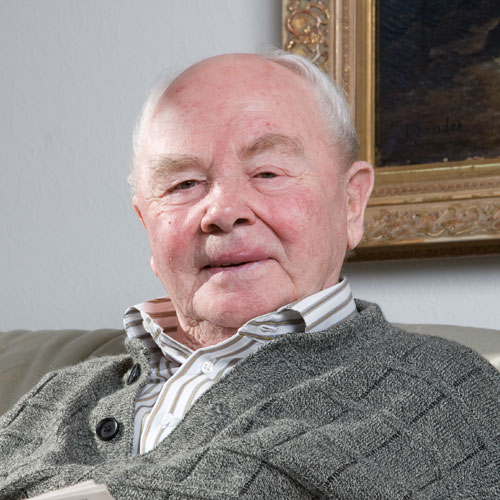84-year-old Günther was told radiation therapy was not an option. To beat a recurrence of cancer, surgeons recommended removal of his left eye, socket and jaw. Gunther’s family sought a second opinion, and found a new way of seeing things at Germany’s University Hospital of Heidelberg.
In 2001, Günther was enjoying his life’s work as owner and keeper of his family’s fruit orchards in the beautiful countryside of Germany. He had recovered well from Gamma Knife® treatment for a head tumor (a cavernous sinus meningioma).
By 2006, Gunther thought he was cancer free. Instead, pressure began to build behind his left eye, causing the eyeball to bulge. Double and triple vision followed. Finally, Gunther could no longer work in his orchards. He scheduled a visit to a nearby physician.
Gunther’s diagnosis was squamous cell carcinoma; a tumor was found in his upper jaw extending behind his left eye.
“The doctors in Frankfurt wanted to do surgery,” Gunther says. In fact, the surgical option presented involved removal of his eye, socket and jaw. Gunther faced a decision requiring a complex, emotional balancing of the possibility that surgery might extend his life with marked concerns about the quality of that life.
Gunther’s niece questioned whether the risks of such extensive surgery were justified for her 84-year-old uncle. She approached a local physician in a search for options and was referred to University Hospital of Heidelberg, and radiation oncologists Prof. Dr. Dr. Jürgen Debus and Dr. Florian Sterzing.
“Gunther’s surgeons recommended a surgery that would have amounted to removing the eye and much of the left side of his face,” Dr. Sterzing says. “Was this a viable option for an 84 year-old man with multiple additional medical problems? I’m not sure.”
Radiation oncologists at University Hospital of Heidelberg examined options for treating Gunther with radiation therapy; his case was a complex mix of constraints and challenges.
“He had received radiotherapy using Gamma Knife® treatment for a previous, unrelated tumor,” Dr. Sterzing says. “His left optic nerve had received the maximum allowable dose of radiation. The squamous cell carcinoma tumor was displacing the left eye, creating a painful pressure.”
Gunther’s treatment required precise delivery of radiation to spare the left optic nerve. At the same time, the pressure behind his left eye and the resulting protrusion of the eyeball made conventional immobilization devices too painful to use during radiation treatments.
The University Hospital of Heidelberg team said immobilization was difficult because the tumor had pressed the eye forward and they worried Gunther would not be able to tolerate the rigid fixation device usually required for IMRT (intensity-modulated radiation therapy). Instead, a very soft head mask was used.
However, since even small movement can affect the accuracy of radiation delivery and resulting dose distribution, the soft head mask could hinder clinicians’ efforts to control exactly where and how much radiation is delivered to the tumor and surrounding healthy tissues.
Prof. Dr. Dr. Debus and Dr. Sterzing believed the TomoTherapy® Hi·Art® treatment system would offer the precision of radiation delivery required to spare the optic nerve while effectively reaching the tumor even when the patient couldn’t be totally immobilized.
University Hospital of Heidelberg radiation oncologists chose TomoTherapy because the daily image guidance capability allowed them to determine the exact location of the tumor and optic nerve immediately before each treatment session.
“We see a lot of head and neck squamous cell carcinoma,” Dr. Sterzing says. “But this situation was unique. The combination of radiation from previous Gamma Knife® surgery coupled with the difficulty with immobilization…the fact that TomoTherapy has daily image guidance was crucial. It enabled us to correct immediately for movement.”
In addition to radiotherapy, Gunther received antibody treatment with cetuximab. This antibody treatment is known to have synergistic effects with the radiation and is better tolerated than chemotherapy.
Antibody treatment actually can increase the effectiveness of radiation therapy. “In the cell itself, the antibody blocks receptors responsible for tumor cell growth,” explains Dr. Sterzing.
Gunther completed 30 sessions of radiation with the TomoTherapy Hi·Art treatment system at University Hospital, Heidelberg.
Gunther had a skin reaction to the antibody infusions and experienced discomfort lying still for extended periods of time during radiation treatments. However, uncomfortable side effects commonly associated with radiation therapy were conspicuously absent.
“TomoTherapy was 1,000 times better than surgery,” Gunther says. “I feel good and I’m happy.”
The University Hospital of Heidelberg clinicians are pleased as well with the oncological result of Gunther’s treatment. “At the moment, we’re seeing complete remission,” Dr. Sterzing says. “One goal was sparing the optic nerve; the patient has full vision in the eye. No nausea. Swelling and protrusion of the eyeball had been 1.5 centimeters. Now, it’s completely gone.”
A CT scan six months after TomoTherapy radiation treatments ended showed no tumor. For ongoing follow-up, Gunther will visit an ear, nose and throat specialist quarterly.
Since its installation at University Hospital of Heidelberg in March, 2006, Prof. Dr. Dr. Debus, Dr. Sterzing and their team have treated 300 patients using the TomoTherapy Hi·Art treatment system.
“Our patients have ranged from 5 years to 90 years,” Dr. Sterzing says. “The value of TomoTherapy is especially apparent with very complex cases….large tumors, close proximity of organs at risk. Situations like Gunther’s where a patient has received radiation therapy previously, or where immobilization is a problem.”
Dr. Sterzing speaks to patients and fellow clinicians about TomoTherapy as a valued tool for treating patients. “It isn’t magic. Sometimes we still lose the fight. But TomoTherapy is an outstanding option, especially for difficult cases. Very good dose distributions are achievable. The daily image guidance gives [clinicians] fewer headaches in planning.”
“TomoTherapy is a safe way to treat with low acute toxicity. Some side effects do occur, but chronic side effects like dryness of mouth with head and neck patients are much less than with standard radiotherapy. We see patients’ recovery is better and faster.”
Gunther is back home, enjoying his orchards, family and friends. He recently celebrated his 85th birthday at a party with his three children, five grandchildren and one great-grandchild.
“I’m happy to be able to take walks again and eat everything I like,” Guenther says. “I’m the happiest person in the world.”



